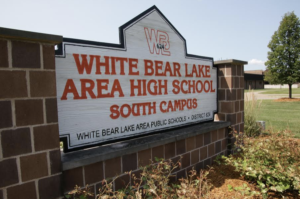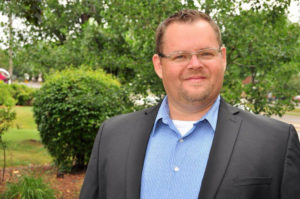White Bear Lake Area Schools Embraces Construction Careers Pathways for Middle and Senior High Students
For many high school students, college seems like the only option after graduation. But for those hoping to work with their hands and go straight into the workforce, and earn while they learn, a career in the construction industry may be the perfect fit.

One school district that has taken the lead in developing alternative career pathways for high school students is White Bear Lake Area Schools (ISD 624). Jenny Moore, Career Pathways Navigator and Jeremy Kerg, College and Career Counselor lead the Career Pathways program at White Bear Lake Area Schools, says the program has been instrumental in connecting students with careers in construction as well as several other industries.
“The program started several years ago when we received a grant to fund a program in manufacturing,” Moore says. “We experienced such a positive impact with the program thatWhite Bear Lake Area Schools decided to keep investing in the program to ensure all students are college and career ready post-graduation.
Today, the White Bear Lake Area Schools’ Career Pathways program offers four career paths for students to explore: construction, healthcare, manufacturing and information technology (IT), which are primarily offered to students in grades 9 through

Jenny Moore
12. The program serves approximately 595 students, of which 65 students participated in the construction track during the 2017-18 school season.
The Career Pathways Program welcomes all students, from those who choose to begin working immediately after graduation to those who decide to pursue a variety of post-secondary degrees. The school’s guidance counselors work with each student to develop a post-graduation career plan, which is required for graduation.
“The program at White Bear Lake Area Schools represents an amazing opportunity for young people,” says Don Mullin, executive secretary of the St. Paul Building and Construction Trades Council and the school board chair of the White Bear Lake Area Schools. “What we’re doing is kicking the door open for students to explore different options, such as careers in construction.”
In addition to attending classes specific to their career track, students can learn about different jobs over Lunch & Learns, listen to guest speakers, attend career fairs, and apply for internships in their respective programs.
With the Construction Career Pathway program, students earn high school credits toward graduation while gaining real-life knowledge about the construction industry.
“Students can sign up for relevant classes specifically designed for those planning to go into construction or a related field after graduating,” Moore explains. “As Career Pathway participants, students have additional opportunities outside of their classes to learn more about the construction skilled trades.”
“We also understand that students are committed to electives such as choir, band, world language, and other engaging classes,” Moore continues. “If a student’s schedule is full and they’re unable to take one of our construction classes, then we encourage them to join the Career Pathways Program to receive notifications of additional opportunities.”
“It also allows students to see how subjects such as math and science are used daily in building Minnesota’s infrastructure (roads, bridges) and buildings,” Mullin adds. “What I hope the young people in our school district see is that there may be a career for them, such as in the construction industry, that appeals to their interests. When we do that, we’re on our way to helping people find careers that they actually enjoy.”
The Construction Apprenticeship Preparation (CAP) program, administered through Construction Careers Pathways, a statewide effort to introduce young adults to careers in construction, provides the technical curriculum for the two construction courses offered by White Bear Lake Area Schools.

Don Mullin
CAP programs are offered by eight Minnesota public school systems, including Minneapolis Public Schools, Rosemount-Apple Valley-Eagan Public Schools, Bloomington Public Schools, Roseville Area Schools, Saint Paul Public Schools, White Beat Lake Public Schools, Mounds View Public Schools and South St. Paul Public Schools. Interest in the program is growing rapidly.
High school students are not the only ones interested in learning more about careers in construction through CAP school curriculum. White Bear Lake Area Schools is introducing middle school students to career opportunities as well.
“We have 25 students, in grades 5 through 9, who participated in the Construction Career Pathways’ Kids at Work summer program,” Moore says.
Kids at Work is a hands-on summer experience for students in grades 5-9 that combines the fun and games of Science, Technology, Engineering and Math (STEM) with exciting activities focused on the construction building trades.
“We hope that all of these students will be inspired to take Construction Career Pathway courses when they come into high school, and eventually pursue careers in the construction industry after they graduate,” she adds.
School counselors, career counselors and the Career Pathways Program at White Bear Lake Area Schools support and encourage all students to pursue post-secondary training and academic opportunities. When students are exploring apprenticeship opportunities and careers in the construction trades, faculty and staff are mindful to mention other important skills such as communications, professionalism and math.
“All of our counselors are so supportive,” Moore says. “They want students to focus on being a productive citizen, whatever that means to them.”
“Our counselors ask every senior to turn in a plan for after high school,” she says. “This set of high school seniors grew up during the Great Recession, and aren’t in any hurry to take on tons of debt right after high school. A career in construction is a great alternative to that, and gives students a chance to work with their hands.”
Like students, parents also need to be educated on viable post-high school options for their children.
“We are starting the conversation with families about what it means to pursue a career in construction,” Moore says.
“At the same time, we’re educating parents about the skilled trades. They don’t always understand how challenging an apprenticeship training program can be,” she adds. “Their child is training to become journeyperson, and that’s no easy task.”
Due to the Construction Career Pathway’s infancy, White Bear Lake Area Schools is working on gathering data for future analysis.
“I use a lot of student testimonials and data in my grant proposals, and the numbers certainly don’t lie,” Moore shares. “We are already having an impact, and in three to five years, we’ll start to see how big that impact really is.”
One person who is seeing an impact is Gretchen Harriman, principal of White Bear Lake Area Schools’ Area Learning Center (ALC). “The parents of the ALC construction students are thankful that their students have found a meaningful career pathway. Some of them are in the trades themselves. Others have seen their students engage in decisions that have created a crossroads where they can choose a positive path or a harmful one — those parents tend to see the Construction Career Pathway Program as a lifeline for their teenagers’ futures.”
Jennifer is highly optimistic that high school construction programs will have a positive impact on students interested in pursuing construction, engineering or technical careers in the future.
“Independent School District 624 supports the growing need for construction careers, and appreciates how much drive and passion our students have shown so far,” says Moore. “We’re going to continue working as hard as we can to make sure that our students are successful at whatever they do after high school.”
“What this is really all about is that these young people are our sons and daughters. They represent our future,” Mullin adds. “By exposing them to careers in construction, we’re helping them see that they have options that will allow them to gain long-term employment that will put them squarely into middle class with fringe benefits they can count on.”
